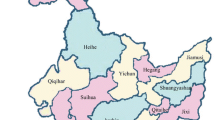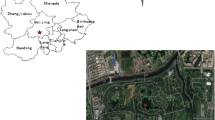Abstract
Monitoring air pollution at a city scale is essential for controlling urban air pollution in cities, especially megacities, in China. In this paper, data for 1 city center site and 5 paired (stands and non-forested) PM2.5 monitoring sites across urban-rural areas in Beijing were collected, and air PM2.5 and influential factors were analyzed. The results showed that the mean value of PM2.5 (February to December 2013) was lower in the stands (67.00 μg m−3) than in the non-forested sites (78.02 μg m−3). The diurnal variation was a bimodal double-dip type, and the average daily PM2.5 was lower in the vegetation areas than in the non-vegetation areas in both Changping Dingling (vegetation) and Changping town (non-vegetation) and showed day > night. In the typical pollution process, accompanied by an increase or decrease in PM2.5 and air quality index values, the higher the PM2.5, the lower the wind speed. PM2.5 in the vegetation areas lagged behind PM2.5 in the non-vegetation areas on typical sunny days but not on typical rainy and windy days. On typical sunny days, the variation of PM2.5 in the vegetation areas was less than that in the non-vegetation areas. PM2.5 did not change significantly under rainy conditions and before a rain, but the variation was smaller after a rain under the typical rainfall process; under typical windy conditions, the variation was not significant. Therefore, in the typical pollution process and under typical weather conditions, the annual and diurnal variations of PM2.5 were smaller in the vegetation areas than in the non-vegetation areas. The above results confirm that the forest has a strong ability to purify air and absorb PM2.5 particulate matter and that the air quality in vegetation areas is better than the air quality in non-forested areas.






Similar content being viewed by others
References
Beckett KP, Freer-Smith PH, Taylor G (2004) Particulate pollution capture by urban trees: effect of species and wind speed. Glob Chang Biol 6:995–1003
Chameides WL, Yu H, Liu SC, et al. (1999) Case study of the effects of atmospheric aerosols and regional haze on agriculture: an opportunity to enhance crop yields in China through emission controls. Proc Natl Acad Sci 96:13626–13633
Charlson RJ, Schwartz SE, Hales JM, et al. (1992) Climate forcing by anthropogenic aerosols. Sciences 255:423–430
Dai W, Gao JQ, Cao G, Ouyang F (2013) Chemical composition and source identification of PM2.5 in the suburb of Shenzhen, China. Atmos Res 122:391–400
Dawson JP, Adams PJ, Pandis SN (2007) Sensitivity of PM2.5 to climate in the Eastern US: a modeling case study. Atmos Chem Phys 7:4295–4309
Esmaiel M, Tess D, Randal S, et al. (2006) Meteorological and environmental aspects of one of the worst national air pollution episodes (January, 2004) in Logan, Cache Valley, Utah, USA. Atmos Res 79:108–122
Freer SPH, Beckett KP, Taylor G (2005) Deposition velocities to Sorbus aria, Acer campestre, populus deltoids × trichocapa Beaupre, Pinus nigraand × Cupressocyparis leylandii for coarse, fine and ultra-fine particles in the urban environment. Environ Pollut. 133:157–167
Gao JH, Wang W, Du J, et al. (1996) Preliminary study on the aerosol characteristics of Xiamen in spring. Res Environ Sci 9:33–37
Gui KH (2007) Characteristics of polycyclic aromatic hydrocarbons PAHs) in PM10 and PM2.5 and the influence of foggy weather conditions during the winter in Nanjing. Nanjing: Nanjing University of information Science & Technology
Guo EG, Wang C, Peng ZH, et al. (2009a) Diurnal variation of airborne particulate matter in 3 typical recreation forests in west mountain of Beijing area in spring. Scientia Silvae Sinicae 45:145–148
Guo EG, Wang C, Qie GF, et al. (2009b) Diurnal variations of airborne particulate matters in different seasons in typical recreation forests in West Mountain of Beijing. Acta Ecol Sin 29:3253–3263
Guo EG, Wang C, Qie GF, et al. (2013) Influence of typical weather conditions on the airborne particulate matters in urban forests in northern China. China Environ Sci 33:1185–1198
Horváth L (2003) Dry deposition velocity of PM2.5 ammonium sulfate particles to a Norway spruce forest on the basis of sand N-balance estimations. Atmos Environ 37:4419–4424
Huang MY, Wang ZF (1998) A model for long-range transport of yellow-sand in East Asia. Scientia Atmospherica Sinica 22:625–637
Hwang HJ, Yook SJ, Ahn KH (2011) Experimental investigation of submicron and ultrafine soot particle removal by tree leaves. Atmos Environ 45:6987–6994
Kim KH, Kim MY, Hong SM, et al. (2005) The effects of wind speed on the relative relationships between different sized-fractions of airborne particles. Chemosphere 59:929–937
Kourtchev I, Warnke J, Maenhaut W, et al. (2008) Polar organic marker compounds in PM2.5 aerosol from a mixed forest site in western Germany. Chemosphere 73:1308–1314
Lai SC, Zou SC, Cao JJ, Lee SC, Ho KF (2007) Characterizing ionic species in PM2.5 and PM10 in four pearl river delta cities, south China. J Environ Sci 19:939–947
Li L, Wang W, Feng JL, et al. (2010) Composition, source, mass closure of PM2.5 aerosols for four forests in eastern China. J Environ Sci 22:405–412
Liu DM, Ma YS, Gao SP, et al. (2005) The pollution level and affecting factors of atmospheric particulates from combustion during spring in Beijing city. Geoscience 19:627–633
Matsuda K, Fujimur Y, Hayashi K, et al. (2010) Deposition velocity of PM2.5 sulfate in the summer above a deciduous forest in central Japan. Atmos Environ 44:4582–4587
Mcdonald AG, Bealey WJ, Fowler D, et al. (2007) Quantifying the effect of urban tree planting on concentrations and depositions of PM10 in two UK conurbations. Atmos Environ 41:8455–8467
Myhre G (2009) Consistency between satellite-derived and modeled estimates of the direct aerosol effect. Science 325:187–190
Noble CA, Mukerjee S, Gonzales M, et al. (2003) Continuous measurement of fine and ultrafine particulate matter, criteria pollutants and meteorological conditions in urban El Paso, Texas. Atmos Environ 37:827–840
Ozaki N, Nitta K, Fukushima T (2006) Dispersion and dry and wet deposition of PAHs in an atmospheric environment. Water Sci Technol 53:215–224
Pio C, Alves C, Duarte A (2001) Organic components of aerosols in a forested area of Central Greece. Atmos Environ 35:389–401
Ren QW, Wang C, Qie GF, et al. (2006) Airborne particulates in urban Greenland and its relationship with airborne microbes. Urban Environ Urban Ecol 19:22–25
Rissanen T, Hyotylainen T, Kallio M, et al. (2006) Characterization of organic compounds in aerosol particles from a coniferous forest by GC-MS. Chemosphere 64:1185–1195
Shen HH, Huang SH, Li RX (1996) Effects of TSP sources and atmospheric factors on the representative of TSP monitoring. Adm Tech Environ Monit 8(15–18):24
Sheng LF, Guo ZG, Gao HW, et al. (2005) Preliminary study on element composition and source apportionment of atmospheric aerosol over Bohai sea. Environ Monit China 21:16–21
Song Y, Tang XY, Fang C, et al. (2002a) Source apportionment on fine particles in Beijing. Environ Sci 23:11–16
Song Y, Tang XY, Zhang YH, et al. (2002b) Effects on fine particles by the continued high temperature weather in Beijing. Environ Sci 23:33–36
Tai APK, Mickley LJ, Jacob DJ (2010) Correlations between fine particulate matter (PM2.5) and meteorological variables in the United States: implications for the sensitivity of PM2.5 to climate change. Atmos Environ 44:3976–3984
Wang XH, Bi XH, Sheng GY (2006) Chemical composition and sources of PM10 and PM2.5 aerosols in Guangzhou, China. Environ Monit Assess 119:425–439
Wang YF, Ma YJ, Lu ZY, et al. (2012a) Atmospheric particle concentration characteristics in Benxi, Liaoning. Environ Chem 31:235–242
Wang J, Wang XK, Zhang HX, et al. (2012b) Comparison of PM2.5 concentrations and elemental compositions in two typical sites in Beijing urban area. Acta Sci Circumst 32:74–80
Wang H, Lu SW, Li SN, et al. (2013) Inhalable particulate matter and fine particulate matter: their basic characteristics, monitoring methods, and forest regulation functions. Chin J Appl Ecol 24:861–868
World Health Organization (2005). WHO Air Quality Guide lines for Particulate Matter, Ozone, Nitrogen Dioxideand Sulfur Dioxide-Global Update Summary of Risk Assessment [EB/OL]. (20050405) [20120508]. http://whqlibdoc. who. int/ hq/2006/ WHO_SDE_PHE_OEH_06. 02_eng.
Xiao YH, Li J, Kuang YW, et al. (2013) Comparison of TSP, PM2.5 and their water-soluble ions from both inside and outside of Dafushan forest park in Guangzhou during rainy season. Acta Ecol Sin 33:6209–6217
Xu H, Lin FM, Bi XH, et al. (2011) Chemical characteristics of atmospheric dust fall and PM10 in Hangzhou. China Environ Sci 31:1–7
Yang DZ, Yu HQ, Ding GA, et al. (2002) An analysis on aerosols in the lower-level atmosphere over Beijing northern suburbs in winter. Q J Appl Meteorol 13:113–126
Zhang D, Iwasaka Y (1999) Nitrate and sulfate in individual Asian dust-storm particles in Beijing, China in spring of 1995 and 1996. Atmos Environ 33:3213–3223
Zhang RJ, Wang MX, Hu F, et al. (2002) Elemental concentrations and distributions of atmospheric particles before and in heating period in Beijing. J Grad Sch Chinese Acad Sci 19:75–81
Zhao CX, Wang YJ, Wang YQ, et al. (2013) Interactions between fine particulate matter (PM2.5) and vegetation: a review. Chinese J Ecol 32:2203–2210
Acknowledgments
This work was financially supported by the Special Fund for Forestry Scientific Research in the Public Interest (No. 20130430101) and the CFERN&GENE Award Funds on Ecological Papers.
Author information
Authors and Affiliations
Corresponding authors
Additional information
Shaoning Li is co-first author.
Rights and permissions
About this article
Cite this article
Chen, B., Li, S., Yang, X. et al. Characteristics of atmospheric PM2.5 in stands and non-forest cover sites across urban-rural areas in Beijing, China. Urban Ecosyst 19, 867–883 (2016). https://doi.org/10.1007/s11252-016-0533-5
Published:
Issue Date:
DOI: https://doi.org/10.1007/s11252-016-0533-5




